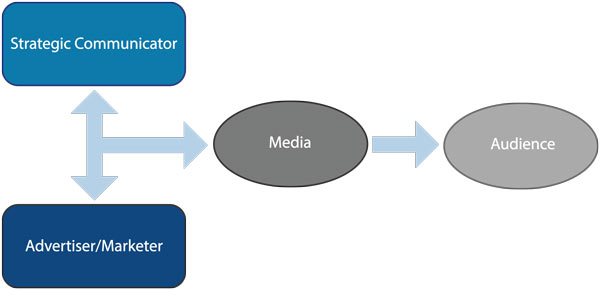Main Content
Lesson 2: Brands and Brand Equity
Actors in the Branding Process
Broadly speaking, there are four main sets of actors in the branding process:
- The marketer or advertiser
- The strategic communicator
- The media
- The audience
These should be thought of as separate roles, not necessarily separate organizations (with the exception of the audience, which is always a separate group from the marketer/advertiser, strategic communicator, and media).
As the figure below implies, the strategic communicator works closely with the marketer/advertiser to develop the brand positioning (message) strategy. This is then transmitted via the media to the audience.

Figure 2.1. Strategic Communication Actors
Keep in mind that these boxes represent roles, not organizations. Therefore, the strategic communicator may work for the marketer/advertising (in the marketing, advertising, or public relations department).
The strategic communicator may also work for the media organization. Many small marketers (usually local but sometimes regional or national) do not have in-house or agency communications talent, and therefore may rely on the media for communications support. In these cases, the media takes on the role of agent as well as media sales. This arrangement is quite common for local newspaper and radio, when local clients need help developing advertising messages and materials. It is also common at the regional and national levels for companies in highly specialized (often B2B) industries. These marketers may be advertising in highly targeted national media (usually magazines) but not do enough advertising overall to justify maintaining in-house communications talent or an agency relationship.
In addition, the media company may be playing the role of marketer. That is, the media company may be marketing itself, either in terms of promoting itself to audiences as a source for content or promoting itself to marketers as a place to buy advertising.
Media companies promoting their content may promote themselves through channels they own or by buying advertising in other media. For example, Fox may promote an upcoming college or NFL football game during other Fox broadcasts or by buying digital advertising on USAToday.com. In either case, Fox is playing the role of a marketer, working with either in-house or agency communications talent to develop a message, and communicating that message through the media to audiences.
Media companies promote themselves to marketers as a place to advertise, called media marketing or advertising marketing. In this case, marketers become the audience. Advertising marketing is often done through direct selling but may also include advertising in trade publications, such as Advertising Age or Adweek (two publications I highly recommend for all advertising and strategic communications students).
As you can see, the basic actors in the strategic communications process are quite straightforward. However, the roles are flexible. Strategic communicators can work for marketers and media companies, the media can assume the role of marketer, and marketers can assume the role of audience.
Given these flexible roles, it can be further pointed out that the modern brand means different things to different actors in the marketing process:
- For marketers, brands are business units.
- As we will see in the section on organization structures for marketing, because brands are the “central organizing concept,” they are often organized as business units.
- For agencies, brands are clients.
- Strategic communicators are typically hired by marketers for long-term, working relationships. The term client is usually reserved for long-term customers with whom a firm has a close working relationship or partnership.
- Agencies also refer to brand clients as accounts.
- For the media, brands are customers.
- The term customer is usually used when a relationship is transactional in nature. For the media, advertisers order space, time, or placements, and may do so for several years. But because marketers don’t usually have the kind of in-depth working partnership with a media company that they do with an agency, they are more accurately seen as media customers.
- As noted above, when the media performs more of the role of strategic communication agent or adviser, it would become more of a client relationship.
- For consumers, brands are symbols.
- Ultimately, marketers and strategic communicators want to create meaning for their brand. And that meaning will be something more than just the manifest aspects of a brand (the colors, typeface, and tagline). That is when brands become something more. They become tangible symbols of something intangible.
When brands are successfully managed to be symbols for consumers, they create brand equity in the marketplace. This concept is explored further in the next section.
